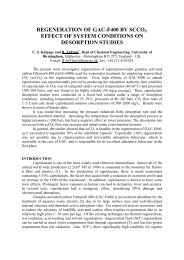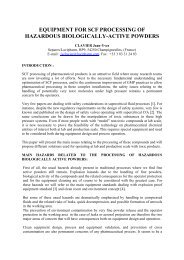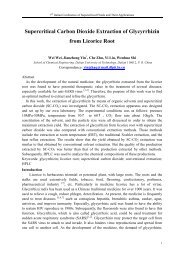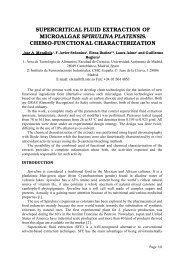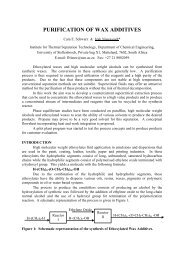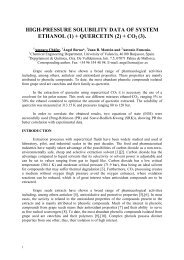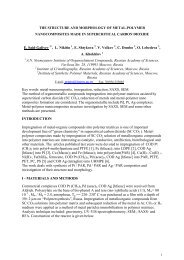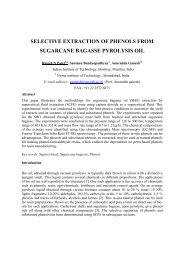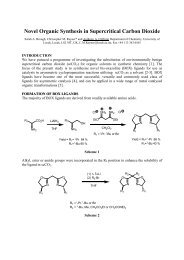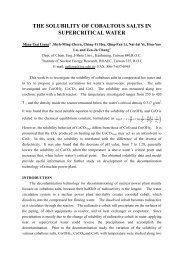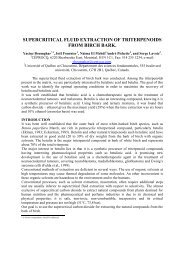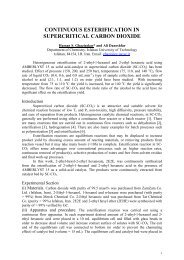EXTRACTION AND ISOLATION OF INDOLE ALKALOIDS ... - ISASF
EXTRACTION AND ISOLATION OF INDOLE ALKALOIDS ... - ISASF
EXTRACTION AND ISOLATION OF INDOLE ALKALOIDS ... - ISASF
You also want an ePaper? Increase the reach of your titles
YUMPU automatically turns print PDFs into web optimized ePapers that Google loves.
and the fractionation costs estimated using the methodology proposed by Turton et al. [7].<br />
The basis used in this calculation was 1 year of operation, or 7920 h (300 days, working 24<br />
hours per day).<br />
Extraction Section<br />
Scale-Up Procedure. The scale-up procedure used assume that both yield and<br />
extraction time of the industrial process will be similar to the laboratorial scale if the ratio<br />
between the mass of particles inside of the extractor and solvent flow rate is kept constant.<br />
Thus, the extraction time was assume to be 2 hours, once after this period no increase in the<br />
yield (0.96%) of the process was observed (see Figure 1); the CO 2 mass flow rate was set at<br />
400 kg/h (considering the bed density equal to the laboratorial scale). The number of<br />
extraction batches per year was 3960.<br />
Fixed Cost of Investment (FCI).The investment of the extraction section is composed<br />
basically by the supercritcal extraction unit. In this work, it was considered an industrial scale<br />
unit containing two 400 liters columns and its estimated price was US$ 2,000,000.00.<br />
Cost of Raw Material (CRM). Tabernaemontana catharinensis is a native tree in the<br />
southern part of Brazil and there is no commercial production of it. Thus, the cost of raw<br />
material was estimated considering its cost equal to the Maté Tea (Ilex paraguariensis) that<br />
has similar herbal structure and that grows at the same region. The commercialization cost of<br />
mate tea is US$ 169.70/ton of leaves and branches [10]. As the alkaloids are present mainly in<br />
the branches, the leaves should be separated and the cost of the branches should be around<br />
US$ 225.00/ton of branches. The pre-processing cost (drying and comminution) was<br />
estimated in US$ 30.00 using the software SuperPro Designer v4.7. Thus, the cost of the raw<br />
material was US$ 255.00/ton. The calculations were done using density of 322 kg/m 3 for a<br />
column volume of 0.4 m 3 , CO 2 consumption make-up of 2% of the total used in the<br />
extraction, and ethanol consumption equal to 10% of the used.<br />
Table 1.Raw material cost in the extraction section<br />
Raw Material Specific Cost (US$/ton) Total Amount (ton/year) Cost (US$)<br />
T. catharinensis 255.00 510 130,050.00<br />
CO 2 150.00 63.3 9,500.00<br />
Ethanol 221.00 [11] 29.2 6,450.00<br />
Total (CRM) 146,000.00<br />
Cost of Operational Labor (COL). The operational cost was calculated using the tables<br />
presented by Ulrich [8]. For a supercritical extraction unit containing two extraction columns,<br />
one CO 2 reservoir, one flash tank, one condenser, one heat exchanger, and one expansion<br />
valve will need 2 operators per shift. The cost of operational labor used was US$ 3.00/hour,<br />
and the total operational cost was US$ 47,520.00.<br />
Cost of Waste Treatment (CWT). It was considered that the particles after extraction<br />
can be sold by the price to remove them from the extraction unit and, therefore, there will be<br />
no solid waste to be treated. The gas that leaves the extraction section is CO 2 and there will be<br />
no treatment on it. The liquid stream is the extract plus co-solvent that is the main product.<br />
Thus, there will be no waste treatment cost in the extraction section.<br />
Cost of Utility (CUT). The cost of the utilities used in the extraction section is<br />
presented in Table 2. The main utility cost is the condensation of the CO 2 after the flash<br />
separation vessel.



